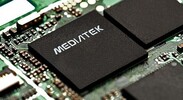Mediatek MT6750N vs Qualcomm Snapdragon 8 Gen 3 for Galaxy
Mediatek MT6750N
► remove from comparison
The ARM-based Mediatek MT6750N SoC (System on a Chip) is a mid-range mobile processor for smartphones and tablets (mostly Android based). It integrates 8 ARM Cortex-A53 cores consisting of 4 high-performance cores clocked at up to 1.5 GHz plus 4 low-power cores clocked at up to 1 GHz each. Furthermore, the SoC integrates a Cat. 6 LTE radio and an ARM Mali-T860 MP2 GPU with 802.11n WiFi and Bluetooth connectivity. Compared to the older MT6750, the graphics card seems to be clocked higher.
The Cortex-A53 is the successor to the Cortex-A7 and introduces 64-Bit support (ARMv8-ISA). Its performance-per-Watt is significantly higher and is even slightly ahead of the old Cortex-A9. If utilizing all 8 of its cores, the Cortex-A53 can rival competing mobile processes in the high-end class range. However, no practical software has been specifically coded to use all 8 cores at such high performance levels.
In addition to the CPU and GPU cores, the SoC also contains a memory controller and the aforementioned Cat.6 LTE modem (FDD/TDD, DC-HSPA+, TD-SCDMA, CDMA2000, EDGE) with both 802.11n WiFi and Bluetooth. The integrated video engine is able to record and playback 1080p videos at up to 30 FPS in hardware. Cameras are supported at up to 16 MP.
The MT6750 is still manufactured in 28nm and so power efficiency is not on par with modern 14/16nm chips.
Qualcomm Snapdragon 8 Gen 3 for Galaxy
► remove from comparison
The Qualcomm Snapdragon 8 Gen. 3 for Galaxy (SM8650) mobile platform is a high end SoC for Android-based smartphones and tablets. Compared to the normal SD8 Gen3, the "for Galaxy" variant offers a 90 MHz higher clocked prime core and a higher clocked GPU.
The cryo-CPU is based on ARM's v9.2 architecture and consists of three clusters: The first includes a fast prime core (ARM Cortex-X4) with up to 3.39 GHz. The second consists of three power cores with up to 3.2 GHz and two additional cores clocking at up to 3.0 GHz (all Cortex-A720). The efficiency cluster consists of two power-saving cores (Cortex-A520) that operate at up to 2.3 GHz. The SoC uses the integrated Adreno 750 for graphics acceleration.
Compared to the Snapdragon 8 Gen. 2 for Galaxy, Qualcomm promises a 25 percent higher GPU clock rate, whose power consumption is said to have been reduced by 25 percent at the same time. Similarly, the CPU's performance is announced to be now a whopping 30 per cent faster and requires 20 per cent less power.
A special focus is also placed on machine learning (AI). The integrated Hexagon NPU is 98% faster than its predecessor and promises a 40% improvement in efficiency. Qualcomm's AI engine is the first to support multimodal generative AI models, including LLM, LVM and ASR, and can process up to 10 trillion parameters directly on the SoC. Image manipulation is said to be possible within fractions of a second. In addition, the NPU of the Snapdragon 8 Gen 3 is also capable of INT4 and Meta Llama 2.
Also back on board is Snapdragon Sight, Qualcomm's brand for camera functions. In addition to Ultra HDR, Dolby HDR is also supported for photos. Photos can now be enhanced by generative AI models and with the Video Magic Eraser (ArcSoft), unwanted people and objects can also be removed from videos. In addition, the ISP is able to distinguish real photos from AI-generated content. This is again a triple ISP (Image Signal Processor), which works with 18 bits and up to 12 layers.
The integrated Snapdragon X75 Modem-RF 5G system allows simultaneous transfers of 5G-mmWave and 5G-Sub6, enabling data rates of up to 10 GBit/s in download and up to 3.5 GBit/s in upload. In addition, the modem is able to support all known 5G bands worldwide. Qualcomm's FastConnect 7800 is once again responsible for local communication, which can handle Bluetooth 5.4 with LE Audio and Wi-Fi 7, among other things.
The SoC is manufactured by TSMC in a 4 nm process.
| Model | Mediatek MT6750N | Qualcomm Snapdragon 8 Gen 3 for Galaxy | ||||||||||||||||||||||||||||||||||||||||||||||||||||||||||||||||||||||||||||||||||||||||||||||||
| Series | Mediatek | Qualcomm Snapdragon | ||||||||||||||||||||||||||||||||||||||||||||||||||||||||||||||||||||||||||||||||||||||||||||||||
| Codename | Cortex-A53 | Cortex-X4 / A720 / A720 / A520 (Kryo) | ||||||||||||||||||||||||||||||||||||||||||||||||||||||||||||||||||||||||||||||||||||||||||||||||
| Series: Snapdragon Cortex-X4 / A720 / A720 / A520 (Kryo) |
|
| ||||||||||||||||||||||||||||||||||||||||||||||||||||||||||||||||||||||||||||||||||||||||||||||||
| Clock | 1500 MHz | 2300 - 3390 MHz | ||||||||||||||||||||||||||||||||||||||||||||||||||||||||||||||||||||||||||||||||||||||||||||||||
| Cores / Threads | 8 / 8 | 8 / 8 1 x 3.4 GHz ARM Cortex-X4 3 x 3.2 GHz ARM Cortex-A720 2 x 3.0 GHz ARM Cortex-A720 2 x 2.3 GHz ARM Cortex-A520 | ||||||||||||||||||||||||||||||||||||||||||||||||||||||||||||||||||||||||||||||||||||||||||||||||
| Technology | 28 nm | 4 nm | ||||||||||||||||||||||||||||||||||||||||||||||||||||||||||||||||||||||||||||||||||||||||||||||||
| Features | Cat. 6 LTE (FDD & TDD), DC-HSPA+, TD-SCDMA, CDMA2000, EDGE, 802.11a/b/g/n WiFi, Bluetooth, 16 MP ISP, 1080p recording/playback, ARM Mali-T860 MP2 GPU | Adreno GPU, Spectra ISP, Hexagon, X70 5G Modem, FastConnect 7800 Wi-Fi 7, LPDDR5x 4800 MHz Memory Controller | ||||||||||||||||||||||||||||||||||||||||||||||||||||||||||||||||||||||||||||||||||||||||||||||||
| iGPU | ARM Mali-T860 MP2 | Qualcomm Adreno 750 | ||||||||||||||||||||||||||||||||||||||||||||||||||||||||||||||||||||||||||||||||||||||||||||||||
| Architecture | ARM | ARM v9 | ||||||||||||||||||||||||||||||||||||||||||||||||||||||||||||||||||||||||||||||||||||||||||||||||
| Announced | ||||||||||||||||||||||||||||||||||||||||||||||||||||||||||||||||||||||||||||||||||||||||||||||||||
| Manufacturer | www.mediatek.com | www.qualcomm.com | ||||||||||||||||||||||||||||||||||||||||||||||||||||||||||||||||||||||||||||||||||||||||||||||||
| L3 Cache | 8 MB |


 Deutsch
Deutsch English
English Español
Español Français
Français Italiano
Italiano Nederlands
Nederlands Polski
Polski Português
Português Русский
Русский Türkçe
Türkçe Svenska
Svenska Chinese
Chinese Magyar
Magyar